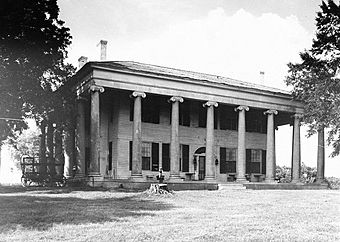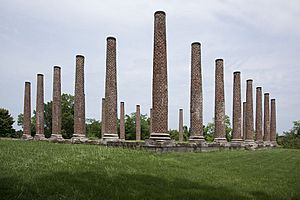The Forks of Cypress facts for kids
|
The Forks of Cypress
|
|

The Forks of Cypress, the main house in 1935.
|
|
| Nearest city | Florence, Alabama |
|---|---|
| Built | 1830 |
| Architect | William Nichols |
| NRHP reference No. | 97001166 |
Quick facts for kids Significant dates |
|
| Added to NRHP | October 10, 1997 |
The Forks of Cypress was once a very large farm near Florence, in Lauderdale County, Alabama. It was known for growing cotton using the forced labor of enslaved people. The farm also had a beautiful house built in the Greek Revival style.
The house was designed by an architect named William Nichols for James Jackson and his wife, Sally Moore Jackson. It was finished in 1830. This house was special because it was the only Greek Revival house in Alabama with a two-story row of columns all the way around it. There were 24 Ionic columns in total.
The name "Forks of Cypress" came from two creeks, Big Cypress Creek and Little Cypress Creek. These creeks bordered the farm and met near where the main house stood. Sadly, the main house was hit by lightning and burned down in 1966. Even though the house is gone, the site is still important. It was added to the Alabama Register of Landmarks and Heritage in 1992 and the National Register of Historic Places in 1997. The State of Alabama now owns the land.
Contents
The History of The Forks of Cypress
James Jackson and the Farm
James Jackson was born in Ireland in 1782. He moved to Alabama from Nashville, Tennessee, in 1818. From 1822, he became active in Alabama's government. He served in both parts of the Alabama Legislature, which is like a state parliament. In 1830, he became the president of the Alabama Senate. This meant he was a very important leader in the state government.
James Jackson loved horses. In the 1820s and 1830s, he brought many English thoroughbred horses to America. He wanted to breed his own horses and make American thoroughbreds better. He was very good at this, especially with three horses: Leviathan, Gallopade, and Glencoe. A historian named John Hervey said James Jackson was the "most successful importer" of thoroughbreds in American history.
James Jackson passed away on August 17, 1840. He was buried in the family cemetery near the farm house. His wife, Sarah Jackson, managed his will. She was in charge of selling off his racehorses over time. This job was finished in 1848 when the horse Glencoe was sold.
The Farm During the Civil War
During the American Civil War, soldiers from the Union army used the land of The Forks of Cypress as a camp. At this time, James Jackson's widow, Sarah Jackson, owned the farm.
Some of the ancestors of the famous writer Alex Haley were enslaved people on this farm. Alex Haley wrote about this farm in his book, Queen: The Story of an American Family.
Later, in 1935, Hugh Scott owned The Forks of Cypress. In the 1940s, he sold it to Rufus B. Dowdy. Mr. Dowdy worked to fix up the house and the land.
The Fire and What Remains
On June 6, 1966, the beautiful plantation house was struck by lightning. It caught fire and burned completely to the ground. The house was never rebuilt. However, the Dowdy family carefully saved the brick columns that were left standing. These columns are still there today, looking like old ruins. The original log house, some other small buildings, and the Jackson family cemetery were also saved. As of 2017, 23 of the original 24 brick columns were still standing.
Replicas of the House
Even though the original house is gone, two copies of it have been built:
- A nearly exact copy of the main house was built in 1983. It is located in downtown Florence, Alabama, about 5 miles from the original site. This building is now a Regions Bank branch.
- Another copy of The Forks of Cypress was built in 2005. It is near the Historic Natchez Trace Parkway in western Lauderdale County, Alabama. This building is a private home and is not open for people to visit.




